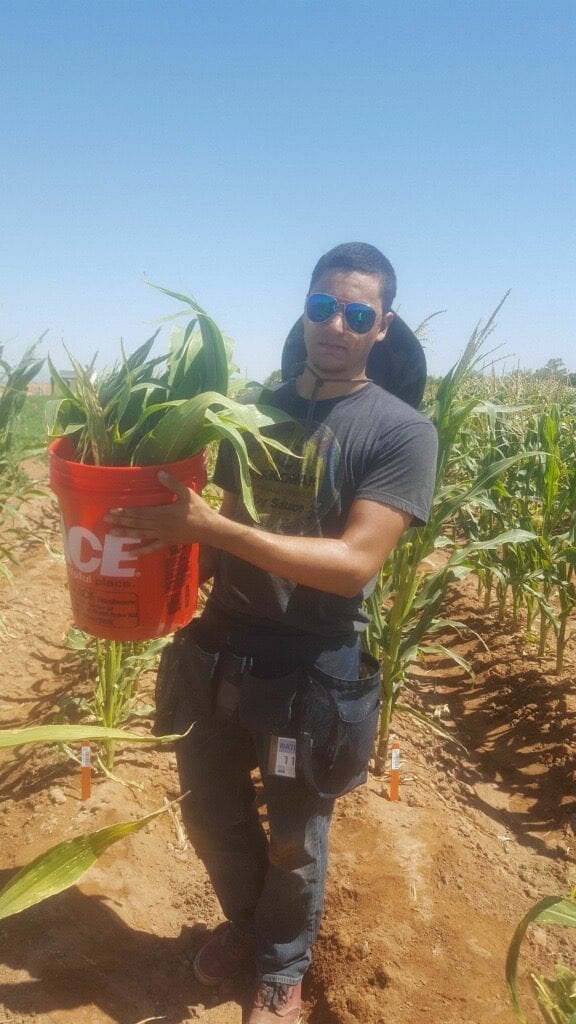News
Maize in Maricopa: An Interview with Intern Michael Miller

Michael Miller pictured in front of the USDA ALARC entrance. Miller spent two weeks at the Center conducting phenotyping work on maize.
Picture this: one day, you’re at BTI on the first day of your new internship, networking with other students and getting settled. Soon after, you’re up bright and early harvesting maize samples on a hot, sunny day in Arizona. That is exactly what PGRP intern Michael Miller experienced recently.
A plant biology major at the University of Nebraska-Lincoln, Michael spent his first two weeks as a PGRP intern at the United States Department of Agriculture’s Arid Land Research Center (USDA ALARC) in Maricopa, AZ.
What is the research project that you are working on?
I am assisting with a large-scale population diversity study that seeks to learn more about the maize leaf cuticle and its role in evaporation. My work in the Gore lab with my mentor Meng Lin focuses on understanding the genetic basis for maize leaf cuticular transpiration. In particular, we are seeking to determine the potential relationship between maize leaf cuticular characters and drought tolerance.
Tell us about a typical day. What were your responsibilities?
We started each day bright and early at 8:00am and would work until 6:00pm. With more than 465 maize genotypes to study, there was no time to waste! I had the opportunity to assist with all aspects of the project, from harvesting samples in the field to refining phenotype data in the lab.
My main responsibilities were to harvest leaves, transport them to our team’s phenotyping station, and assist with imaging and data collection. Now that I’m back at BTI, I am working on associated coding and statistical analysis using the data we collected in Maricopa.
 What made you interested in this project?
What made you interested in this project?
Maize is definitely my favorite plant, so working on this project was something I thought I could excel in as a PGRP intern. I believe it is important for researchers to learn more about maize since it is such an important staple crop.
I see this project as one piece of the puzzle in understanding how to increase the water-use efficiency of maize plants. I’m really excited to be working on this project because our findings could help breeders develop more drought-tolerant crops.
What challenges did you face, and how did you overcome them?
Like any research project, the trip had its challenges. Because of the large scope of this project, there were lots of researchers rotating in and out at any given time. New people equals constant training on protocol and guidelines, and can create gaps in completing time-sensitive tasks.
However, working in a team helped to keep everyone accountable and we all stepped up to fill gaps in tasks that needed to be done. Working in a team setting also put an appropriate amount of pressure on me to do my job well. This trip gave me an idea of the real-life challenges research teams can face and how to develop strategies to overcome them.
What did you find most surprising or interesting during your trip?
I was particularly surprised at how much I learned about computer programming. Working on a GWAS [genome-wide association study] and learning to use R [programming language] has made me realize how critical computer programming can be. Data and statistical analysis is such a useful skill and I am amazed at how much I have already learned so far.
On a personal note, the scenery was amazing. While the plains were flat as a pancake, you could see the unobstructed mountains everywhere you turned. It was remarkable in so many ways. I was pleased to have one free evening to take a short road-trip. To my surprise, William Boyce Thompson had long ago established an arboretum along the route of our trip. It was such an unbelievable fluke that we just had to stop and take some photos in front of the sign.

Michael and Gore Lab manager, Nick Kaczmar, at the Boyce Thompson Arboretum.
Overall, what are the benefits you will take away from this experience?
Often there haven’t been many opportunities for me to get involved in field work. I really valued the opportunity to gain in-the-field experience during my trip and the experience has given me a better idea of what I may want to pursue in graduate school, and perhaps even a career path. I am enjoying what I am learning so far. I would like to continue to conduct research in maize in the foreseeable future.
Michael Miller is assisting with this project as part of a larger collaboration with the Laurie Smith Lab at the University of California-San Diego and the Scanlon Lab at Cornell University. Michael will present his research at PGRP’s annual Summer Symposium on August 10th, 2017. If you are interested in attending, please contact Kelli Monce at ksm84@cornell.edu.

